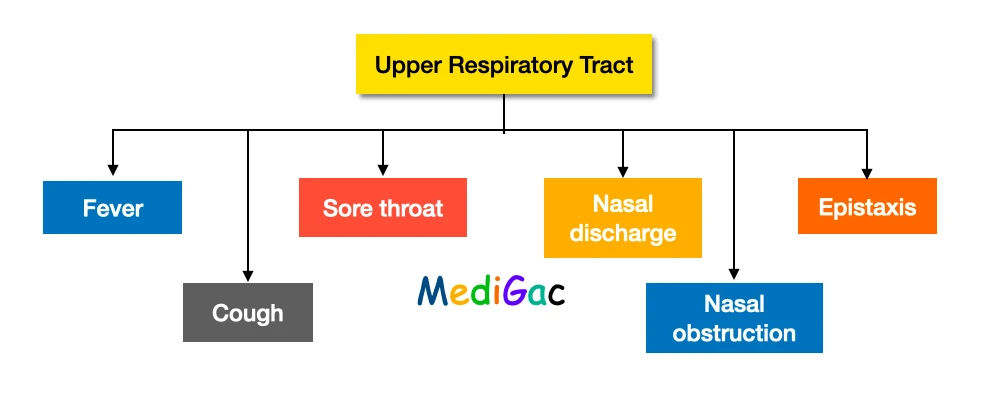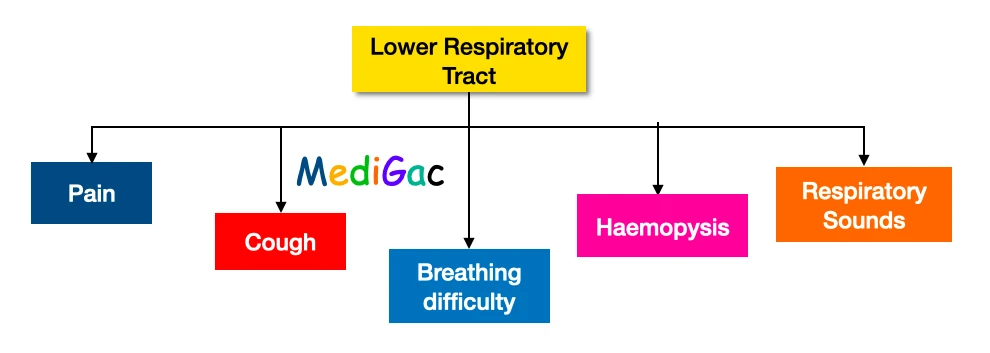
There are presenting complaints according to upper and lower respiratory tract.
Upper respiratory tract – The nose or nostrils, nasal cavity, mouth, throat (pharynx), and voice box are the principal routes and structures of the upper respiratory tract (larynx). A mucous membrane lines the respiratory system, which secretes mucus. Smaller particles, like as pollen or smoke, are trapped by the mucus.
Lower respiratory tract – The windpipe (trachea) and the bronchi, bronchioles, and alveoli are the principal passageways and structures of the lower respiratory system. Each bronchus splits into secondary and tertiary bronchi deep within the lungs, branching out to smaller airways known as bronchioles.
Upper respiratory tract

1. Fever with associated symptoms :
Due to any kind of infection or inflammation, the body tries to react against those foreign bodies or particles. So the body test heated up and the patient present with fever.
2. Cough :
A cough, also known as tussis, is a deliberate or involuntary act that clears foreign particles, bacteria, irritants, fluids, and mucus from the throat and breathing path; it is a fast ejection of air from the lungs. Coughing can be done intentionally or as a reflex.
This is a frequent sign of a respiratory infection. Cough is a typical nocturnal symptom of sinusitis caused by postnasal drip.
3. Sore throat :
Infections, such as a cold or flu, often cause pain or irritation in the throat, which can occur with or without swallowing.
- This is most common in viral nasopharyngitis, and it’s accompanied by nasal watering and conjunctival congestion.
- Associated with white pharyngeal exudate and swollen painful submandibular lymph node, sterptococcal (Group-A beta-haemolytic) pharyngotonsillitis.
4. Nasal discharge :
We have divided the nasal discharge types by categorising it into three features – Character of the discharge, duration of the discharge. , And the Involvement of unilateral or bilateral site
I. Duration of the nasal discharge :
- If the duration is about greater than 10-15 days, then the most common causes should be the Sinusitis
- If the discharge is persistent and purulent and often presents with foul smelling, then this can be due to Foreign body in nose and Nasal polyp.
II. Character of the nasal discharge :
There are mainly two types of nasal discharge – Watery or mucoid and Mucopurulent or frankly purulent
- Watery or mucoid – This type of discharge can occur due to common cold, sinusitis and allergic rhinitis
- Mucopurulent or frankly purulent – This mainly occurs due to foreign body in nose, nasal polyp with secondary infection, sinusitis.
III. Site involvement of the nasal discharge :
- Mostly the major of the discharges are bilateral
- If the discharges are unilateral, then this can be due to some specific causes and they are – Sinusitis, Nasal polyp and Foreign body inside the nose.
5. Nasal obstruction :
- Unilateral nasal obstruction can be caused by a foreign body or polyp, or it can be congenital, such as in the case of choanal atresia.
- Inflammatory nasal conditions are fairly prevalent. Breast-feeding may be hampered in small newborns.
6. Epistaxis :
Blood is seen via the anterior nares. Blood may be consumed or breathed through the posterior nares, resulting in the sensation of vomiting or coughing (haematemesis and haemoptysis, respectively).
There are several causes of nose bleed, they are :
- There is no moisture in the air.
- Picking of nose.
- Excessively blowing one’s nose.
- The nose has been injured.
- Allergies and colds.
- Object lodged in the nostrils.
Lower respiratory tract

1. Pain in the chest :
This incidence occurs very rarely. The causes can be divided into two types, and they are – Pulmonary causes, and Non-pulmonary causes.
A. Pulmonary causes :
The pulmonary causes are :
- Empyema
- Pneumothorax
- Pneumonia
- Bronchiectasis
- Foreign body
B. Non-Pulmonary causes :
2. Cough :
There can be presence of four types of cough that is dry cough and moist cough.
- Dry cough –
This is the irritation of the respiratory mucosa with the least amount of exudation : Asthma, Respiratory diseases in their early stages and Tubeculosis causes a lymph node to press against the bronchus.
- Moist cough – Almost all respiratory mucosal irritation with exudation results in this. Pneumonia, TB, cystic fibrosis, and bronchiectasis are examples.
- Night Cough – This is the release of cough during night time, and this can be due to Bronchial asthma, Bronchiectasis, gastro-oesophageal reflux disease, Post-nasal drip in sinusitis, and Paroxysmal nocturnal dyspnoea.
- Whooping cough – In whooping cough, there is a paroxysmal cough with a “whoop,” vomiting, and even fainting.
3. Difficulty in breathing :
Difficulty in breathing can occur due to various reasons, and the causes can be divided into two types that is Acute/sudden and Insidious.

I. Acute or Sudden :
This mainly occurring from shot time period or has the sudden incidence. The causes are :
- Foreign body inhalation
- Paroxysmal nocturnal dyspnoea
- Bronchial asthma
- Pneumothorax
II. Insidious:
progressing in a steady, subtle manner, yet with extremely damaging consequences. The causes can be :
- Bronchitis/Bronchial asthma
- Bronchiectasis
- Pneumonia
- Pleural effusion or empyema
- Pulmonary tuberculosis
III. Respiratory causes:
- Restrictive lung diseases – Miliary tuberculosis, and pulmonary oedema
- Upper airway – Acute laryngotracheobronchitis, Laryngeal diphtheria, Acute laryngitis
- Peripheral airway – Tropical pulmonary eosinophilia, Bronchial asthma
- Increased physiological dead space due to Pneumonia, Collapse of lung
- Due to respiratory muscle paralysis like in G.B syndrome, Neurotoxic snake bite and spinal muscular atrophy
- Any disease of chest wall like ankylosing spondylitis
IV. Other causes:
- Due to severe anaemia
- Cardiac causes – Heart failure
- Metabolic system dysfunction – Acidosis by diarrhoea, diabetic ketoacidosis, and uraemia. And Salicylate poisoning
4. Haemoptysis :
A vigorous cough brings up small amounts of blood mixed with sputum (or, more critically, significant amounts of bright red blood).
Common causes of haemoptysis are :
- Pulmonary atriovenous malformation
- Pulmonary tuberculosis
- Bronchiectasis
- Acute tracheitis and bronchitis
5. Respiratory sounds :
The patient can present with five types of respiratory sounds, and they are – Wheezing, Throat sound, Grunting, Stridor, Rattling sound.

I. Wheezing :
While breathing, a high-pitched whistling sound is produced. There are several respiratory causes of wheezing :
- Brachial asthma
- Acute bronchitis
- Lower respiratory tract infection
- Pneumonia
- Acute left ventricular failure with pulmonary oedema
- Foreign body inhalation
- Pulmonary tuberculosis
Other causes are :
- Gastro esophageal reflux disease
- Bronchiectasis
- Cystic fibrosis
- Interstitial lung disease
- Congenital respiratory diseases
- Tropical pulmonary eosinophilia
II. Grunting:
The grunting of a newborn is mainly related to digestion. The baby is merely becoming accustomed to the milk or formula of his or her mother. They may have gas or pressure in their stomach, which makes them feel uneasy, and they haven’t yet learned how to let it out.
This can occur due to :
- Kerosene aspiration
- Hyaline membrane diseases
III. Stridor :
Stridor is a melodious, abnormally high-pitched breathing sound. A obstruction in the throat or voice box causes it (larynx). It is most commonly heard when inhaling.
There are several causes of this, and they are :
- Infective causes like acute laryngitis, epiglottitis, laryngeal diphtheria, spasmodic laryngitis
- Foreign body inhalation
- Due to any congenital diseases like tracheomalacia, laryngomalacia, congenital laryngeal cyst.
- Neoplastic causes like laryngeal papilloma
IV. Rattling sound :
After coughing, a coarse interrupted inspiratory sound occurs during secretions in the trachea and major bronchi.
This can occur due to any inflammation, infections which can cause secretions.